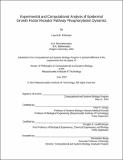| dc.contributor.advisor | Peter K. Sorger and Douglas A. Lauffenburger. | en_US |
| dc.contributor.author | Kleiman, Laura B | en_US |
| dc.contributor.other | Massachusetts Institute of Technology. Computational and Systems Biology Program. | en_US |
| dc.date.accessioned | 2010-08-31T14:46:51Z | |
| dc.date.available | 2010-08-31T14:46:51Z | |
| dc.date.copyright | 2010 | en_US |
| dc.date.issued | 2010 | en_US |
| dc.identifier.uri | http://hdl.handle.net/1721.1/57796 | |
| dc.description | Thesis (Ph. D.)--Massachusetts Institute of Technology, Computational and Systems Biology Program, 2010. | en_US |
| dc.description | Cataloged from PDF version of thesis. | en_US |
| dc.description | Includes bibliographical references (p. 157-168). | en_US |
| dc.description.abstract | The epidermal growth factor receptor (EGFR, also known as ErbB 1) is a prototypical receptor tyrosine kinase (RTK) that activates multi-kinase phosphorylation cascades to regulate diverse cellular processes, including proliferation, migration and differentiation. ErbB 1 heterooligomerizes with three close homologues: ErbB2, ErbB3 and ErbB4. ErbB1-3 receptors are frequently mutated, overexpressed or activated by autocrine or paracrine ligand production in solid tumors and have been the target of extensive drug discovery efforts. Multiple small molecule kinase inhibitors and therapeutic antibodies against ErbB receptors are in clinical use or development. Despite their importance as RTKs, oncogenes and drug targets, regulation of ErbB receptors by the interplay of conformational change, phosphorylation, phosphatases and receptor trafficking remains poorly understood, and the impact of these dynamics on physiological activity and cellular responses to anti-ErbB drugs is largely unknown. This thesis investigates the dynamic opposition of kinases and phosphatases within the ErbB pathway. By standard biochemical analysis, ErbB receptors and downstream proteins appear to become phosphorylated and then dephosphorylated in approximately 30 minutes. However, pulse chase experiments where cells are exposed to ligand and then to small molecule kinase inhibitors reveal that individual proteins must in fact cycle rapidly between being phosphorylated and dephosphorylated in seconds. We construct a succession of differential equation-based models of varying biochemical resolution, each model appropriate for analyzing a different aspect of ErbB regulation, to help interpret the data and gain quantitative insight into receptor and drug biology. Rapid phosphorylation and dephosphorylation of receptors has important implications for the assembly dynamics of signalosomes. We find that signals are rapidly propagated through some downstream pathways but slowly through others, resulting in prolonged activation in the absence of upstream signal. We show that fast phosphorylation/dephosphorylation may provide cells with the flexibility necessary to rapidly detect and respond to changes in their extracellular environment. These fast dynamics also play a crucial role in determining the response to ErbB 1-targeting cancer therapies, which we find to vary significantly between drugs with different mechanisms of action. We show that treatment with one class of these drugs results in sustained signaling, instead of inhibition, and thus may actually promote tumor proliferation or invasion. Our work may help explain why certain drugs have been more effective in patients than others and suggests new approaches for evaluating biochemical signaling networks and targeted therapeutics. | en_US |
| dc.description.statementofresponsibility | By Laura B. Kleiman. | en_US |
| dc.format.extent | 168 p. | en_US |
| dc.language.iso | eng | en_US |
| dc.publisher | Massachusetts Institute of Technology | en_US |
| dc.rights | M.I.T. theses are protected by
copyright. They may be viewed from this source for any purpose, but
reproduction or distribution in any format is prohibited without written
permission. See provided URL for inquiries about permission. | en_US |
| dc.rights.uri | http://dspace.mit.edu/handle/1721.1/7582 | en_US |
| dc.subject | Computational and Systems Biology Program. | en_US |
| dc.title | Experimental and computational analysis of epidermal growth factor receptor pathway phosphorylation dynamics | en_US |
| dc.title.alternative | Epidermal growth factor receptor pathway phosphorylation dynamics | en_US |
| dc.type | Thesis | en_US |
| dc.description.degree | Ph.D. | en_US |
| dc.contributor.department | Massachusetts Institute of Technology. Computational and Systems Biology Program | |
| dc.identifier.oclc | 654106113 | en_US |
